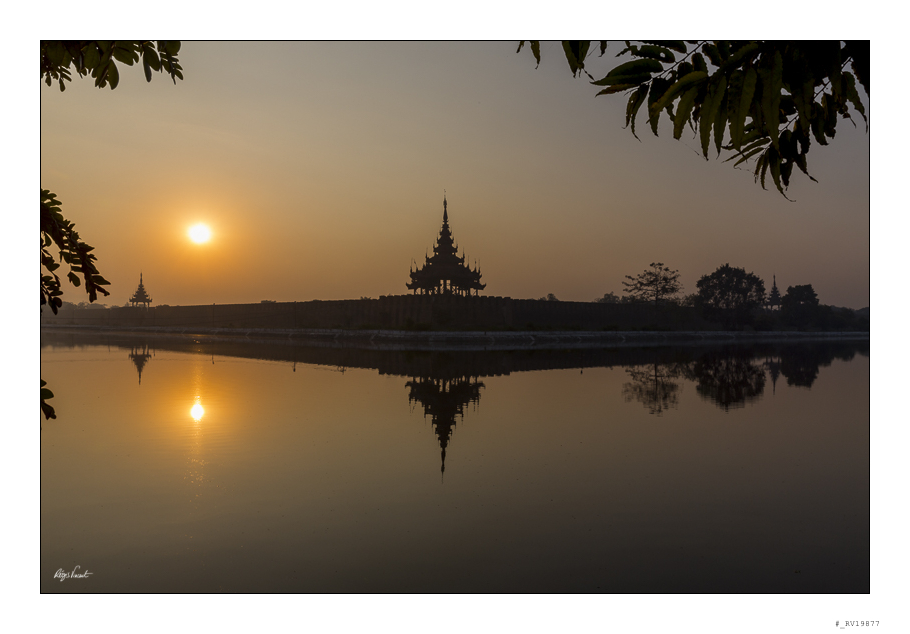Mandalay is the second-largest city and the last royal capital of Burma. Located 445 miles (716 km) north of Yangon on the east bank of the Irrawaddy River, the city has a population of one million, and is the capital of Mandalay Region. Mandalay is the economic hub of Upper Burma and considered the center of Burmese culture.
Mandalay is also known for its monks. Half of the country’s monks reside in Mandalay and surrounding areas. After our flight from Yangoon, we went directly to “Marble Street”. It’s a street where most marble buddha statues are made. They are made by men with drills and angle grinders and then polished by hand by the women.
The entire street is filled with marble dust, it’s everywhere. We stayed for about 1 hour and my camera was already showing sign of white dust all over it.
One morning we went to Sutaungpyei Pagoda on top of Mandalay Hill at dawn. I have a strong preference for sunrise over sunset and in Burma even more. Sunrises are way quieter than sunsets, you can enjoy the pagoda almost by yourself (except for Tuan and my wife on the left side of this image).
There was a couple monks at sunset in this pagoda, when one of them got his iPad out to take a picture of the sunrise, I could not resist and snap his picture. I love the juxtaposition of the traditional world that the monk represents and the iPad representing the current world.
Burma is one of those places on Earth where everything is manual, even making gold leaves. At the Gold Pounders Workshop we watched how a gold bar was pounded by hand in wafer-thin gold leaves. Not a single machine, all made by hand, like the buddha statues earlier.
Like I said earlier, more than half of the Burmese monks lives in Mandalay or its surroundings. You will see them everywhere. For the 3 days we were in Mandalay, I try to capture moments of their daily routine.
The monks are not begging, even if you might think that by looking at the images. The Alms offering involves giving to others as an act of virtue, either materially or in the sense of providing capabilities (e.g. education) for free. Every morning monks travels to neighborhood and receive food or money from the people.
Our guide was a 3rd time monk drop-out so he knew what the monks schedule was. We got invited to see the evening prayer just before the monastery closes for the night. It’s a very moving ceremony and did not want to disturb it with any flash. I had to resort to very high ISO and quiet moment to get this image.
Monks even have their own university, that’s one of the benefit of becoming a monk is the education one receives as a monk. We met with monks who spoke perfect english and french because that’s what they study.
One morning we went to Mandalay fort before sunrise and again it was so peaceful and quiet compared to the same spot at sunset. The top image was taking that morning.
At a short boat ride from Mandalay is the town of Mingun on the Irrawaddy River. It’s a very small town but quite famous for the largest pagoda ever attempted to be built. It’s absolutely enormous. It was never finished because of an astrologer claiming that, once the temple was finished, the king would die.
This is the 7th post about my trip to Burma, the last one will be about our incredible time around Inke Lake.
- part 1: Burma/Myanmar – Shwedagon pagoda
- part 2: Burma/Myanmar – Sule Pagoda
- part 3: Burma/Myanmar – Kandawgyi Lake
- part 4: urma/Myanmar – Kyaukhtatgyi, Nga Htat Gyi and Botataung Pagodas
- part 5: Burma/Myanmar – Bagan pagodas and temples (Shwesandaw, Shwezigon and Sulamani
- part 6: Burma/Myanmar – Bagan monks
All the images presented here are available for licensing or as fine art prints.



























